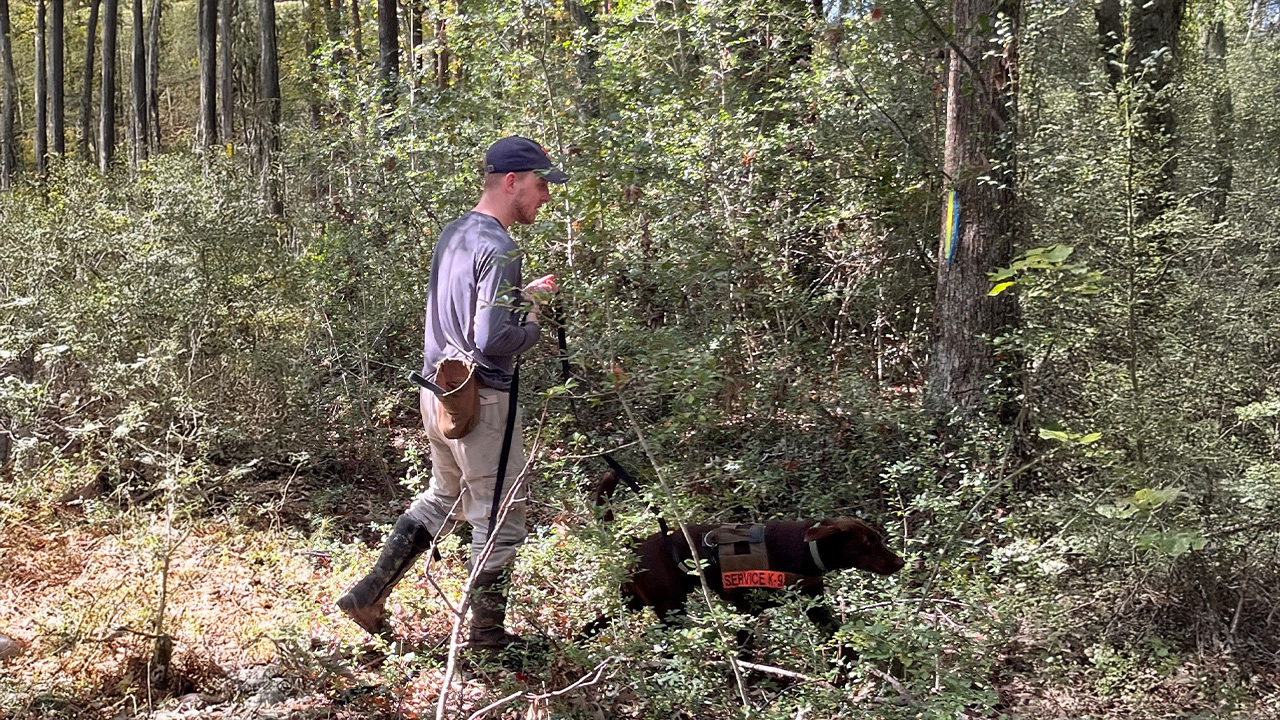content body
The Asian longhorned beetle, a threat to U.S. trees, will soon have a new foe: Labrador retrievers bred and trained by Auburn University to search for the invasive species.
The retrievers are part of the College of Veterinary Medicine’s Canine Performance Sciences (CPS) program, which uses canines to detect plant and animal species in ways that benefit ecological research, management and conservation.
As part of a partnership with the U.S. Department of Agriculture (USDA), this project will reach its goal to train operational dogs for Asian Longhorned Beetle detection in 2025 with an anticipated spring start date. Their work will help find the beetle sooner which in turn helps the agency stop the beetles’ spread.
CPS Assistant Director Melissa Singletary said finding the beetles is important because they damage economically and environmentally important hardwood trees.
“Infested trees become safety hazards. Branches can drop and trees can fall over, especially during storms. The beetles degrade the ability of those trees to be used as lumber, and they affect the overall health of ecosystems,” she said.
About the pest
Also known as the starry sky, sky beetle or ALB, the adult Asian longhorned beetle has a polka-dotted back, a shiny black body and striped antennae that are up to twice as long as its one-to-two-inch body.
As a larva, it bores into a tree’s heartwood. As a newly emerged adult, it will feast on leaves and twigs. Infested trees can’t repair the damage, so affected branches can fall and, as the infestation progresses, the trees can die.
In the United States, the insect has killed tens of thousands of hardwood trees, mainly maples, since it was first discovered in Brooklyn, New York, in 1996. While the beetle has never been found in Alabama, it has been found in Illinois, Massachusetts, New Jersey, Ohio and South Carolina. Infestations in Illinois and New Jersey have been eliminated.
“We need more help looking for and reporting tree damage now more than ever,” said Josie Ryan, the Animal & Plant Health Inspection Service’s (APHIS) National Policy Manager for the Asian Longhorned Beetle Eradication Program.
“The dogs are another tool to help us find the beetle.”
Taking advantage of lab’s nose for nuisances
The CPS-USDA partnership is just one of the latest ways Auburn is putting canines’ keen sense of smell to work to benefit humans and the environment.
Dogs can smell most anything with an odor, from explosives to illegal drugs to diseases. They can do that with better sensitivity and rapid mobility than any current technology. They can cover large acres of land within a relatively short time allowing for area reduction with surveillance programs, Singletary said.
To train dogs to search for the Asian longhorned beetle, CPS scientists rely on the beetles’ waste material, known as “frass.” Once they’ve learned to detect frass, the dogs will accompany USDA workers into forests, searching for active infestations.
“The dogs have to be able to work within a very dynamic environment containing many odors and distractions,” Singletary said. “They have to be able to manage that environment, and they have to keep up their endurance and stamina to work under field conditions.”
Learn about CVM’s Canine Performance Sciences program
Leave it to the dogsBreeding dogs with the right traits
To breed dogs with advanced olfactory sensibilities and traits such as endurance and determination, the CPS takes a scientific approach that blends multiple disciplines, according to Singletary.
“We span the gamut of what we call nose-to-tail in a dog,” she said. “We cover areas of olfaction, neuroscience, genetics and genomics, physical performance and their overall operational capabilities.”
Each year, the program produces 45 to 65 puppies, with the goal of advancing the science of breeding dogs for detection services. The puppies go through months of training that socializes them and teaches them to hunt and investigate for rewards.
CPS sells dogs to agencies interested in the dogs’ capabilities and asks them to report on the dogs’ performance through the years.
“We produce dogs for the purpose of conducting the research into the breeding and practices necessary for reproductive management in purpose-bred detection dogs,” Singletary said. “We don’t produce a large number of dogs for production; however, it's important we look at placing dogs operationally, so we can get the necessary feedback on their performance in the field as a component of the research.”
Extending the One Health approach
The Asian longhorned beetle project not only furthers the science of performance dog breeding, it also complements Auburn’s One Health initiative, led by the College of Veterinary Medicine. The One Health concept considers the connection among the health of humans, animals and the environment.
“A lot of what we do at Canine Performance Sciences has a One Health focus, whether that’s looking at the security and safety of individuals or keeping our forests and our environment healthy,” Singletary said.
“The dogs are on the front lines, which obviously plays an important role in ensuring the overall health of ecosystems that affect plants, animals and humans, which are part of them.”







